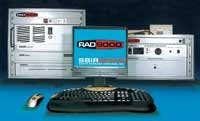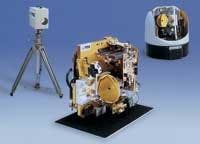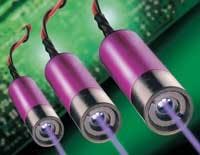Santa Barbara Infrared delivers optical test equipment to U.S. Navy
Santa Barbara Infrared Inc. in Santa Barbara, Calif., is delivering the RAD9000 spectral radiometer, which its engineers designed for the U.S. Navy. The system helps calibrate projector-level test systems and stand-alone test components such as blackbodies and discrete targets. Company engineers designed the system to conform to Navy requirements for high thermal sensitivity and increased radiometric accuracy. Navy officials are using the RAD 9000 to test and calibrate equipment operating in the mid-wave and long-wave infrared spectral bands. The system has an electro-optical module with interchangeable detector and radiometry modules, radiometric reference module, and reference control module. For more information contact Santa Barbara Infrared online at www.sbir.com.
Army looks to EOIR Technologies for surveillance prototypes
Engineers at EOIR Technologies Inc. in Woodbridge, Va., are designing prototype surveillance and force-protection technology for the U.S. Army under terms of a $25 million contract from the Army Night Vision and Electronics Sensor Directorate (NVESD) at Fort Belvoir, Va. EOIR is a subsidiary of Markland Technologies Inc. in Ridgefield, Conn. Markland is working on night-vision and advanced-sensor applications, disposable sensors, and other threat-detection systems for NVSED. Many of the products and services being delivered on this contract use next-generation electro-optic and infrared sensor technologies that are being used in direct support of U.S. military combat operations in Iraq, Afghanistan, and elsewhere. The Army’s NVESD has been responsible for key innovations in the fields of optical electronics and thermal imaging for weapons targeting, electronic surveillance and other mission-critical military applications. For more information contact Markland Technologies online at www.marklandtech.com.
Pulse generator is for high-resolution military photonic applications
Quantum Composers in Bozeman, Mont., is offering the 9500 Plus pulse generators to generate and synchronize several pulses for optoelectronic and process control for research and testing in military and aerospace laboratories. The device helps the user multiplex several channel pulses onto one output to create complex pulse trains for flash lamps, Q-switches, shutters, cameras, and other imaging applications. It synchronizes as many as eight different events or instruments, and digitally controls as many as eight independent channels for laser timing, automated testing, and precision-pulse applications. For more information contact Quantum Composers online at www.quantumcomposers.com.
KVH to upgrade optical navigation systems
KVH Industries Inc. in Middletown, R.I., will upgrade vehicular navigation systems on deployed military vehicles under terms of $1.9 million order from an unnamed defense prime contractor. KVH experts will upgrade KVH’s TACNAV navigation systems already in the field, enabling the navigation system to connect with the U.S. Army’s Force-21 Battle Command, Brigade-and-Below system, otherwise known as FBCB2. KVH’s TACNAV military vehicle navigation systems employ KVH’s digital compass and fiber optic gyro (FOG) technology as well as proprietary software algorithms to provide uninterrupted navigation, heading, and pointing data for vehicle drivers, commanders, and crews. While TACNAV complements GPS, its self-contained sensors operate independently of GPS, and can provide mission-critical data for troops in the vehicle as well as to the digital battlefield system, even if GPS is blocked, jammed, or is otherwise unavailable. For more information contact KVH online at www.tacnav.com.
Bidirectional adaptive-optics laser communications subsystem
AOptix Technologies in Campbell, Calif., is offering the GT1.0 Communicator bidirectional adaptive-optics method of beam control. It has a range of more than 16 miles with virtually zero probability of intercept or detection, company officials say. The device is in a 26-pound 9-by-13-by-13-inch chassis that operates on battery power for more than eight hours of continuous operation. In ground applications, the system enables building-to-building line-of-sight links directly through windows. It provides 800 gigabits-per-second bandwidth with a fiber source, and 1-gigabit Ethernet with an appropriate communications interface. For more information contact AOptix online at www.aoptix.com.
Fiber-optic-based multiparameter test kit
FISO Technologies Inc. in Quebec City is offering the Dynamic Multi-Parameter Test Kit based on the Fabry-Perot (FPI) optical-sensor technology. The kit has of Fabry-Perot (FPI) fiber-optic sensors covering applications in laboratories or research centers. The system includes temperature, pressure, strain, and refractive index sensors. Fiber-optic sensors using FPI are desired because of their versatility, their performance and their dynamical range. For more information contact FISO online at www.fiso.com.
Stratos Lightwave optical transceivers meet MIL-STD-810E
Stratos Lightwave LLC in Chicago is offering a family of ruggedized small-form-factor (SFF) optical transceivers that are validated for compliance with MIL-STD-810E for shock, vibration, and other environmental extremes. These transceivers need no additional rework or testing to meet the requirements of military and avionics standards, company officials say. The Stratos transceivers come in vertical-cavity surface-emitting-laser (VCSEL) and light-emitting-diode (LED) versions. The LED version operates at 1310 nanometers with data rates from 1 to 300 megabits per second, and supports data links as long as 1.2 miles. The VCSEL version operates at 850 nanometers and is for Gigabit Ethernet, Fibre Channel, or InfiniBand, and supports data links as long as 1,600 feet. Both versions operate in temperatures from -40 to 85 degrees Celsius. For more information contact www.stratoslightwave.com.
Blue-violet laser-diode modules
Photonic Products Ltd. in Hatfield Broad Oak, England, is offering 405-nanometer blue-violet laser-diode modules for applications such as imaging, fluorescence sensing, spectroscopy, microscopy, and biomedical imaging. The modules produce either an elliptical output beam of 4-by-1.5 millimeter with output of 4 milliwatts, or a 2-millimeter circular output beam with output power of 0.9 milliwatts. The glass AR-coated optical lens adjusts to produce a collimated beam or focused spot. Operating voltage is from 8 to 12 volts DC at an operating current of 90 milliamps, or 100 milliamps. For more information contact www.photonic-products.com.
Kopin demonstrates tiny high-resolution color displays
Kopin Corp. in Taunton, Mass., is demonstrating its 0.59-inch color CyberDisplay that offers resolution of 800 by 600 pixels for mobile applications such as military wearable computers, as well as mobile communications devices. Kopin manufacturers these displays with a proprietary color-filter technology and low-voltage interface. The CyberDisplay consumes less than 100 milliwatts of power. Company officials say the display is for high-resolution, full-color applications such as mobile video eyewear, 3-D stereoscopic video, mobile computing, and emerging military products. For more information contact Kopin online at www.kopin.com.






